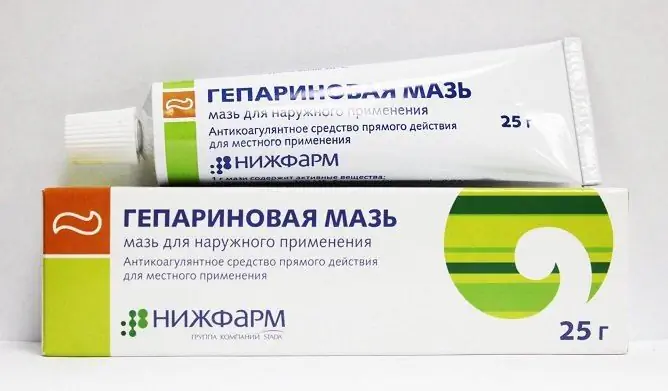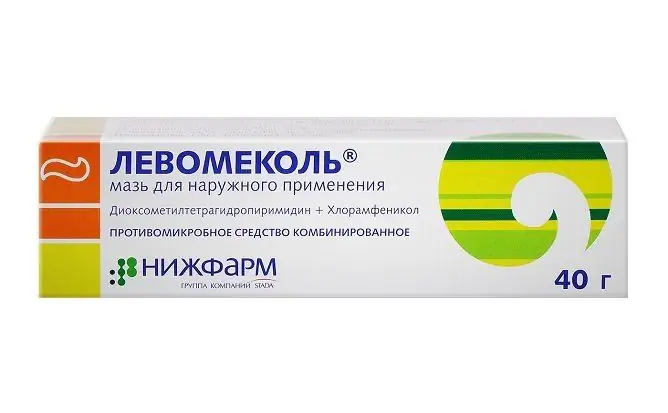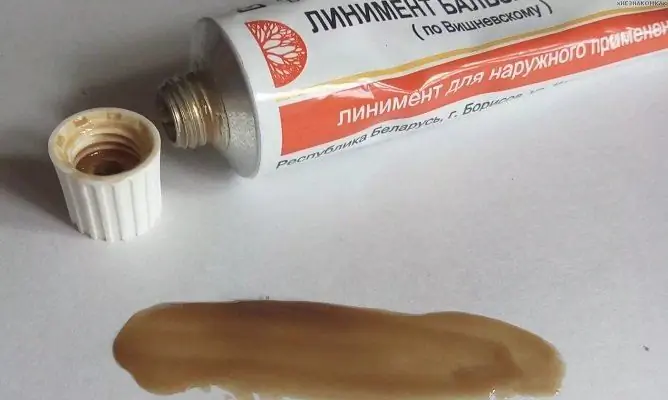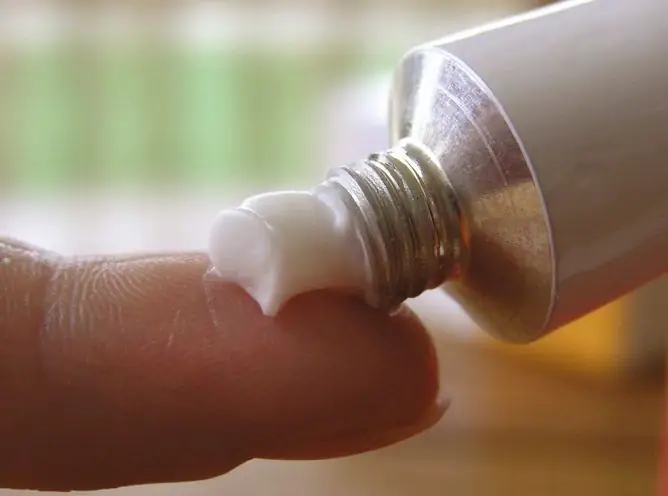- Author Rachel Wainwright [email protected].
- Public 2023-12-15 07:39.
- Last modified 2025-11-02 20:14.
Sulfargin
Sulfargin: instructions for use and reviews
- 1. Release form and composition
- 2. Pharmacological properties
- 3. Indications for use
- 4. Contraindications
- 5. Method of application and dosage
- 6. Side effects
- 7. Overdose
- 8. Special instructions
- 9. Application during pregnancy and lactation
- 10. Use in childhood
- 11. In case of impaired renal function
- 12. For violations of liver function
- 13. Drug interactions
- 14. Analogs
- 15. Terms and conditions of storage
- 16. Terms of dispensing from pharmacies
- 17. Reviews
- 18. Price in pharmacies
Latin name: Sulfargin
ATX code: D06BA01
Active ingredient: sulfadiazine (Sulfadiazinum)
Manufacturer: Tallinn Pharmaceutical Plant (Estonia)
Description and photo update: 2018-22-10
Prices in pharmacies: from 261 rubles.
Buy

Sulfargin is an external preparation with antibacterial, bactericidal and antifungal effects.
Release form and composition
The dosage form of Sulfargin is an ointment for external use 1%: almost white or white, with a characteristic odor (50 g each in aluminum tubes, in a cardboard box 1 tube).
Composition of 100 mg ointment:
- active substance: silver sulfadiazine - 1 mg;
- auxiliary components: propylene glycol - 10 mg; liquid paraffin - 23 mg; cetostearyl alcohol - 6 mg; polysorbate-80 - 2 mg; glyceryl monostearate 40-55 - 3 mg; propyl parahydroxybenzoate - 0.02 mg; methyl parahydroxybenzoate -0.08 mg; purified water - up to 100 mg.
Pharmacological properties
Pharmacodynamics
Sulfargin is one of the broad-spectrum antimicrobial agents; sulfonamide. Has a bactericidal effect.
The drug is active against gram-negative / gram-positive bacteria (Proteus spp., Escherichia coli, Klebsiella spp., Staphylococcus spp.), As well as dermatophytes and Candida spp.
The bactericidal effect of Sulfargin is due to the activity of silver ions, the release of which occurs in the wound as a result of the dissociation of the silver salt of sulfadiazine. Moderate dissociation is observed (release occurs gradually), which ensures the constancy of the antimicrobial action. In addition to this, the bacteriostatic effect of sulfadiazine is observed (also released during the dissociation of the silver salt of sulfadiazine).
Sulfargin is characterized by moderate osmotic activity. The drug does not possess necrolytic properties.
From the total amount of the applied ointment from the damaged wound / burn surface, up to 1% of silver ions and up to 10% of sulfadiazine are absorbed.
Indications for use
Sulfargin ointment is prescribed for the treatment and prevention of purulent burns and wounds with mild exudation, as well as bedsores and trophic ulcers.
The drug is used in the following cases:
- treatment of fresh burn surfaces (in order to prevent infectious complications);
- treatment of pressure sores, trophic ulcers, long-term non-healing wounds (including stump wounds);
- treatment of wound and burn surfaces in stage I of the wound process with mild exudation;
- treatment of wounds and burns of I - IIIA degree in II - III stages of the wound process.
Contraindications
- severe deficiency of glucose-6-phosphate dehydrogenase;
- pregnancy and the period of breastfeeding;
- age up to 1 year;
- individual intolerance to the components of the drug.
It is not necessary to use Sulfargin in the treatment of deep purulent wounds and burn surfaces with abundant exudation.
Instructions for the use of Sulfargin: method and dosage
The drug is used externally.
Ointment Sulfargin is applied in a thin layer (2-4 mm) in an open way or under a bandage after surgical debridement and removal of necrotic tissue.
The dressing should be changed 1-2 times a day or less often. The maximum single dose is 300 g.
Duration of use is up to 3 weeks.
Side effects
- local reactions: rarely - a short local irritating effect in the form of pain or burning (usually disappears on its own after 5-10 minutes);
- systemic reactions: with prolonged therapy on extensive burn areas - disorders of the digestive system, including dyspeptic symptoms, changes in the picture of peripheral blood (leukopenia), allergic reactions in the form of skin manifestations characteristic of sulfa drugs.
Overdose
Overdose information is not provided.
special instructions
When carrying out therapy in large areas, monitoring of the functional state of the liver and kidneys and the content of blood corpuscles is required.
During the use of the drug, patients are shown an abundant alkaline drink.
Application during pregnancy and lactation
Sulfargin is not prescribed during pregnancy and breastfeeding.
Pediatric use
According to the instructions, Sulfargin is not prescribed for children under 1 year old.
With impaired renal function
In cases of using the ointment on large areas, it is necessary to monitor the state of renal function.
For violations of liver function
When applying the ointment to large areas, it is required to monitor the state of liver function.
Drug interactions
There are no data on the interaction of Sulfargin with other drugs / substances.
Analogs
Dermazin is an analogue of Sulfargin.
Terms and conditions of storage
Store in a place protected from light at temperatures up to 25 ° C. Keep out of the reach of children. Do not store in the freezer or refrigerator.
Shelf life is 2 years.
Terms of dispensing from pharmacies
Available without a prescription.
Reviews about Sulfargin
According to reviews, Sulfargin is an affordable and effective drug that is used for bedsores, burns, wounds, cuts and other skin disorders. The ointment is often used as an ambulance. There is a lack of odor, a non-greasy consistency, as well as softening of the skin after using the drug. There are practically no reports of the development of side effects.
The price of Sulfargin in pharmacies
The approximate price for Sulfargin (in tubes of 50 g) is 280-360 rubles.
Sulfargin: prices in online pharmacies
|
Drug name Price Pharmacy |
|
Sulfargin ointment for external use 1% tube 15g 261 r Buy |
|
Sulfargin 1% ointment for external use 50 g 1 pc. 293 r Buy |
|
Sulfargin ointment for outside. approx. 1% tube 50 g 433 r Buy |

Anna Kozlova Medical journalist About the author
Education: Rostov State Medical University, specialty "General Medicine".
Information about the drug is generalized, provided for informational purposes only and does not replace the official instructions. Self-medication is hazardous to health!






